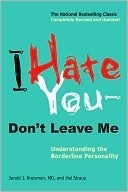More on this book
Community
Kindle Notes & Highlights
Sustained periods of contentment are foreign to the borderline.
A borderline childhood is frequently a desolate battlefield, scarred with the debris of indifferent, rejecting, or absent parents, emotional deprivation, and chronic abuse. Most studies have found a history of severe psychological, physical, or sexual abuse in many borderline patients. Indeed, a history of mistreatment, witness to violence, or invalidation of experience by parents or primary caregivers distinguishes borderline patients from other psychiatric patients.16,17 These unstable relationships carry over into adolescence and adulthood, where romantic attachments are highly charged and
...more
A child emotionally, the borderline cannot tolerate human inconsistencies and ambiguities; he cannot reconcile another’s good and bad qualities into a constant, coherent understanding of that person. At any particular moment, one is either “good” or “evil”; there is no in-between, no gray area. Nuances and shadings are grasped with great difficulty, if at all. Lovers and mates, mothers and fathers, siblings, friends, and psychotherapists may be idolized one day, totally devalued and dismissed the next. When the idealized person finally disappoints (as we all do, sooner or later), the
...more
This highlight has been truncated due to consecutive passage length restrictions.
In a sense, the borderline is like an emotional explorer who carries only a sketchy map of interpersonal relations; he finds it extremely difficult to gauge the optimal psychic distance from others, particularly significant others. To compensate, he caroms back and forth from clinging dependency to angry manipulation, from gushes of gratitude to fits of irrational anger. He fears abandonment, so he clings; he fears engulfment, so he pushes away. He craves intimacy and is terrified of it at the same time. He winds up repelling those with whom he most wants to connect.
The work world can provide sanctuary from the anarchy of their social relationships. For this reason, borderlines frequently function best in highly structured work environments.
Borderlines are often very intelligent and display striking artistic abilities; fueled by easy access to powerful emotions, they can be creative and successful professionally.
The borderline’s unstable relationships are directly related to his intolerance of separation and fear of intimacy. The borderline is typically dependent, clinging, and idealizing until the lover, spouse, or friend repels or frustrates these needs with some sort of rejection or indifference, then the borderline caroms to the other extreme—devaluation, resistance to intimacy, and outright avoidance. A continual tug-of-war develops between the wish to merge and be taken care of, on the one hand, and the fear of engulfment, on the other.
In relationships, these internal feelings are dramatically translated into intense, shifting, manipulative couplings. The borderline often makes unrealistic demands of others, appearing to observers as spoiled. Manipulativeness is manifested through physical complaints and hypochondriasis, expressions of weakness and helplessness, provocative actions, and masochistic behaviors. Suicidal threats or gestures are often used to obtain attention and rescue. The borderline may use seduction as a manipulative strategy, even with someone known to be inappropriate and inaccessible, such as a therapist
...more
This highlight has been truncated due to consecutive passage length restrictions.
Along with affective instability, anger is the most persistent symptom of BPD over time.32
Borderline anger may represent a cry for help, a testing of devotion, or a fear of intimacy—whatever the underlying factors, it pushes away those whom the borderline needs most. The spouse, friend, lover, or family member who sticks around despite these assaults may be very patient and understanding, or, sometimes, very disturbed himself. In the face of these eruptions, empathy is difficult and the relation must draw on every resource at hand in order to cope (see chapter 5).
It has been observed that borderlines often have borderline mothers, who, in turn, have borderline mothers.
Major traumas—parental loss, neglect, rejection, physical or sexual abuse—during the early years of development can increase the probability of BPD in adolescence and adulthood. Indeed, case histories of borderline patients are typically desolate battlefields, scarred by broken homes, chronic abuse, and emotional deprivation.
Dealing with borderline behavior can be frustrating for everyone in regular contact with the borderline personality because, as we have seen, their explosions of anger, rapid mood swings, suspiciousness, impulsive actions, unpredictable outbursts, self-destructive actions, and inconsistent communications are understandably upsetting to all around them.
Borderlines typically respond to depression, anxiety, frustration, or anger with more layers of these same feelings. Because of the borderline’s perfectionism and tendency to perceive things in black-and-white extremes, he attempts to obliterate unpleasant feelings rather than understand or cope with them. When he finds that he cannot simply erase these bad feelings, he becomes even more frustrated or guilty. Since feeling bad is unacceptable, he feels bad about feeling bad. When this makes him feel worse, he becomes caught in a seemingly bottomless downward spiral.
Adjusting to a world that is continually inconsistent and untrustworthy is a major problem for the borderline. The borderline’s universe lacks pattern and predictability. Friends, jobs, and skills can never be relied upon. The borderline must keep testing and retesting all of these aspects of his life; he is in constant fear that a trusted person or situation will change into the total opposite—absolute betrayal. A hero becomes a devil; the perfect job becomes the bane of his existence. The borderline cannot conceive that individual or situational object constancy can endure. He has no laurels
...more


